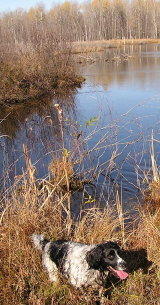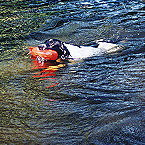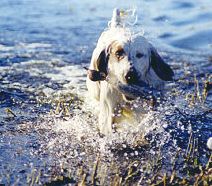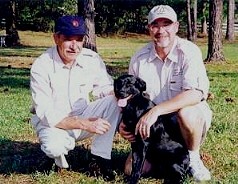  In the last article we were talking about the very basics of water work; getting your dog into water and having him come back to you with a retrieve.
But as anyone that goes hunting realizes, it is not always that simple. A fast flowing river or tide can easily wash a bird very quickly from the fall area. Even a strong wind can move a floating duck some distance from the fall. Also, there can be obstructions in the water… rushes, reeds and fallen branches. In tidal waters, waves may obstruct the dogs view of the fall as he swims out. Plus, of course, mud - a big obstacle for many dogs unless they have experienced it.
So often, although our dog is good at what we give him to do in training, he struggles on the real thing because we never really prepare him for what we will encounter in the shooting field. For example, a simple thing… how many train their dog to sit in a hide (a blind) and catch only a glimpse of a falling bird, plus hear the shot from inside the hide? We expect them to be able to handle this - even if we have never prepared them for it before.
To be really sure of your dog and its ability to deal with many differing situations it is only fair to prepare him as much as is feasibly possible. In summer the conditions are not the same as winter but we can simulate many situations to some degree. Part of the training for duck shooting in winter has to be getting your dog marking the sound of a splash - especially in poor light. Therefore, once you have him confidently retrieving from water, take him out early morning or late evening when light is poor and start with short retrieves building up to more difficult ones over rushes and behind bushes along the bank. Teach him to mark with his ears. A little word of warning though when you cannot see very well, either. Always pre-check the areas you are asking him to enter the water when in the dusk you cannot see what is there yourself. The last thing you want is your dog injuring himself on hidden stakes or other obstacles.
"However you progress in water, the most important preparation is to get your training right on land, first."
However you progress in water, the most important preparation is to get your training right on land, first. If your dog is obedient and willing on land, then water is a steady progression. If he is not right on land, then there is no way you can correct him in water and he will learn that all too quickly.
Once I have my dog entering water confidently, I start to angle the retrieves so that he works and enters the water at varying angles and distances from the bank. I give retrieves among rushes, reeds, water lilies and other water plants as his ability and confidence grows. In this way, he becomes skilled at swimming or marking over or in them.
Reeds and rushes can be a big problem for some dogs as they will stick in them and hunt rather than go through to get to the fallen duck on the other side. If you lower your head to your dog’s eye level, you will realize why this is. He sees it fall and it looks to him as though it is in the reeds. From our height, we can see and we know from experience it has fallen beyond. In addition, reeds and rushes hold scent that is like a magnet to a dog. It only needs one hiding moorhen or coot to create a strong distraction. So now we have to get him ‘punching’ through reeds and recognizing that a retrieve lies on the other side. Teaching your dog to "go back" on hand signals is a great help and we will deal with that in later articles. But repeated practice at retrieving over rushes or through a riverside bush quickly develops a dogs natural ability to recognize the situation. With some, it takes time. Yet others seem to get the idea very quickly and they keep going in a straight line through everything until they hit scent or see it. These dogs have a confidence in their ability to mark the line of a fall and if it isn’t where they thought it had fallen, then they realize it must be further out on the same line.
When your dog has become confident at retrieving from water, begin to give him retrieves across to the far bank. Initially, make the distance across the water short but then build it up. Also, of course, increase the obstacles along the way to the retrieve. The reason for this is that once you have your dog finding dummies in the water, he can easily begin to assume that everything shot falls in the water. Therefore, for the situations when a bird falls on the far bank, he needs to be taught to get over and not stick to swimming around in the water. Even when you have got a dog that will swim over to the far bank, you then have to teach him to go through the reeds on that side also. Again, these can hold a lot of scent, so your dog needs to be taught to go right over and hunt the far bank, when required. Repetition to give experience helps tremendously, but once you have taught him to handle on land on an unseen retrieve (dummies that he has not seen down), this ability will provide you with a first class way of picking those elusive birds over water.
Depending on your dogs age and ability plus the length of retrieve, give him three or four retrieves across water and then possibly one in the water. Often, I will throw the last one in water as a diversion to simulate me shooting another duck while he is retrieving a previous one. Again, this must have been done on land first to obtain the control and obedience. Once he is good at working on this distraction, you can begin to do double retrieves and even throw another dummy as the dog is swimming out to one and tell him to leave it and get the original. On shooting days, all types of situations can occur and your dog has to handle them, so build up his abilities gradually and set up realistic scenarios. The most important bird to get when shooting is the one that is wounded or is floating away. Easy birds we can pick at leisure, therefore your hunting companion needs to be taught to take commands and pick the ones that will prove difficult to collect, if not done promptly.
Dummy launchers are quite useful for wide rivers and lakes when you are working alone or there is no bridge close by, but don't use a launcher ball as this can cause the dog to gag as he swims back. Use a launcher and thrown dummies and begin to build up working situations to simulate runners, unseens and dead birds - on and over water.
The other distraction a wildfowler’s dog may have to face is decoys. These can be very distracting and it is wise to get your dog familiar with them. Some dogs will spook at them. Others will go across to investigate and forget what they were sent for and, on occasions, a dog can become quite afraid of them if it gets tied up in the anchoring strings and panics. Initially, lay them out in a field and let your dog walk around to sniff and check them out. Then follow up with some simple retrieves through them. Once he is totally ignoring them on land, set them up on water. Do some simple retrieves among them and then through them until the distance the dummy falls behind is long or on a distant bank.
Go to different stretches of water with more difficult entries and exits - not everything is easy - and your dog has to learn to negotiate difficult banks. Usually a dog will attempt to exit water the way he has gone in. Sometimes he will attempt to take a short cut to the nearest shoreline or he may be washed downstream by the current where that point of exit could prove to be difficult. Therefore, you have to teach him to keep his head and find ways out that he can manage. When working him, if there is any doubt and he is struggling, never be slow to go forward to help and guide.
For anyone who shoots where there is water, it is worth spending time training your dog in water. For the enthusiastic wildfowler, it is essential and will minimize the loss of birds. And nothing brings a thrill to the heart like a dog that is seen coming back, duck in mouth after a difficult retrieve in water. It feels better than any shot you can make. Therefore use the warm summer months to build the experience and training and have fun doing it – your dog will.
|



